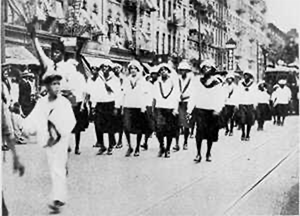
Women in the Garvey Movement
Although the U.N.I.A. did not have an explicit program against sexism, it did, through groups such as the Black Cross Nurses and Universal Motor Corps, offer women a place of their own within the organization.
Women were subordinate to men within the U.N.I.A. as in many other membership organizations. But these women's auxiliaries and the U.N.I.A.'s Juvenile Division helped to complement male-identified U.N.I.A. divisions like the African Legion. They offered women a chance to develop leadership and organizational skills and a place to express their commitment to the ideals of the U.N.I.A.
The Black Cross Nurses auxiliary was modeled on the Red Cross.
Like other auxiliary divisions of the U.N.I.A., the Black Cross Nurses were organized locally.
The first unit was established by members of the Philadelphia U.N.I.A. Henrietta Vinton Davis, one of the key national leaders of the U.N.I.A., recruited women to local Black Cross Nurse groups in the early 1920s, and local units were formed in cities in the United States, Central America, and the Caribbean.
The Black Cross Nurses formed their contingent in U.N.I.A. parades, strikingly appearing in long cowled white robes or green nursing uniforms.
Although some members had formal medical training, most worked with practical training in first aid and nutrition.
The auxiliary performed benevolent community work and provided public health services to black neighborhoods, specializing in infant health and home care.
In some localities, they worked in conjunction with established social services agencies.
The Universal African Motor Corps was a female auxiliary whose units were affiliated with local divisions and associated with the paramilitary African Legion, the membership of which was exclusively male.
While the head of the Motor Corps, who was given the title Brigadier General, was a woman, the officers and commanders of the units were men.
Members of the Corps were trained in military discipline and automobile driving and repair.
The Juvenile Divisions, the youth corps of the Garvey movement, were affiliated with local U.N.I.A. divisions and divided into classes according to age.
The infant class (ages one through seven) studied the Bible, the doctrine of the U.N.I.A., and the history of Africa.
After the age of seven, the children were segregated by sex.
Girls were taught sewing, boys woodcraft, and both received further instruction in black history and etiquette.
After the age of thirteen, boys received military training to prepare them for membership in the African Legion. At the same time, girls learned hygiene and domestic science to prepare them to be Black Cross Nurses.
The superintendent of each local division was the Lady Vice President of the division at large, and teachers were chosen from the adult auxiliaries.
The juvenile divisions took part in U.N.I.A. parades; the boys marched in blue uniforms and the girls in green dresses.

